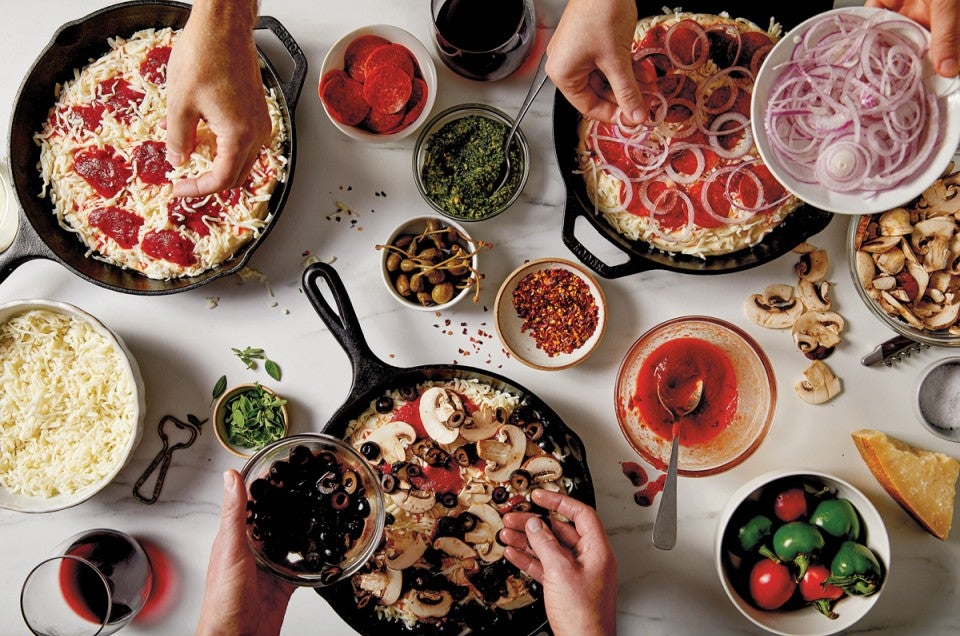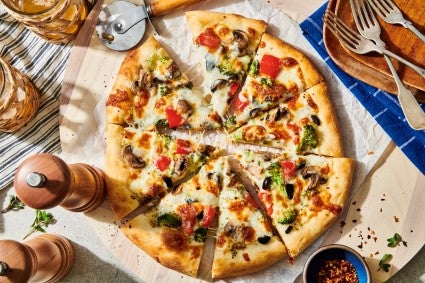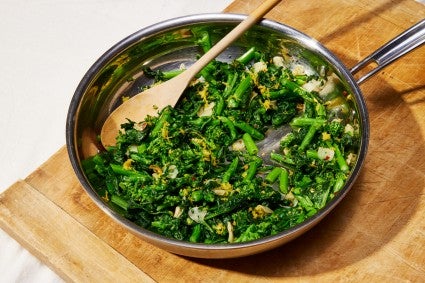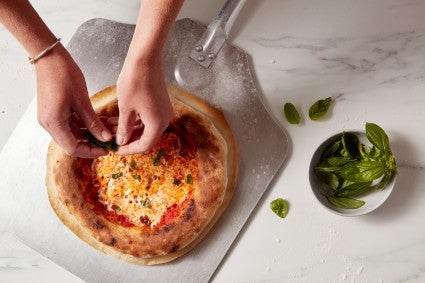


You've made the perfect pizza dough, shaped it beautifully, and chosen your cheese and sauce. Now it's time for toppings: You can just dump whatever sounds tasty on there, right?
Not quite! The toppings you add — and how you add them — is actually a crucial step. The right moves can make your pizza even better, while the wrong ones can lead to a soggy or underbaked pie.
To guide you, we have Jonathan Frishtick, an instructor at our Baking School who regularly teaches pizza classes, sharing his best tips for topping pizza.

If there’s one lesson you take away from this guide, it’s less is more: Don’t overload your pizza with toppings. “If you’re overlapping your toppings a lot and layering them up over one another, that’s going to be a problem,” says Jonathan. That’s because too many toppings will weigh down your pizza and add too much moisture; this, in turn, prevents your crust from fully browning. As a result, you wind up with a pizza that has a flabby bottom crust instead of a crispy one. So be judicious with your toppings, and err on the side of too few instead of too many. “If you really like a lot of stuff on your pizza, maybe just fold things over and make a calzone,” suggests Jonathan.
Freeze the cheese. “If grating low-moisture mozzarella for your pizza, freeze it first so it doesn’t get gummy while going through the cheese grater,” recommends Jonathan. You want to partially freeze it (twenty minutes is about right) but don’t freeze it solid, or else grating will become impossible. (And when it comes to cheese, Jonathan recommends avoiding pre-shredded mozzarella if you can and grating your own! Pre-shredded cheese neither tastes as good nor melts as well as cheese that you shred yourself.)

Roast your veggies. Jonathan highly suggests roasting vegetables before putting them on your pizza, especially if they’re high in water, like zucchini, mushrooms, peppers, and onions. Not only does this add another layer of flavor, but it also ensures your vegetables are fully cooked, as often the pizza bake time isn’t long enough to actually cook most vegetables through. Crucially, pre-roasting your vegetables allows you to rid them of extra moisture. Moisture is the enemy of crisp crust, and if you drop on raw vegetables they’ll just steam on there, releasing liquid that will make your crust gummy and soggy. Save energy and time by roasting the vegetables in your preheating oven; by the time they’re ready, your crust will be prepared for topping. Toss them with olive oil and salt and pepper before roasting; this is a good opportunity to use herbs or flavored oil like garlic-infused oil.
Cook fatty meats beforehand. Before adding to your pizza, sauté any meats that may be high in fat, like Italian sausage. You don’t have to completely cook the meat, but you do want to release some of the fat so that your pie is not overwhelmed by it, as excess fat can also weigh down your crust. There’s no need to pre-cook cured meats, such as pepperoni, ham, or prosciutto.
Take advantage of the broiler. “If you put a bunch of toppings on your pizza and you’re not getting the top to brown as much as you want, use your broiler,” recommends Jonathan. “But keep an eye on it, because the top of the pizza can burn quickly.”

Use basil the right way. Jonathan likes to chiffonade his basil (in other words, cut it into thin, ribbon-like strips) and add it after the pizza comes out of the oven so it stays fresh, crisp, and bright green. If you want to add basil before your pie goes in the oven, cover the basil with cheese so it doesn’t turn black in the oven.
Sprinkle on a little extra flavor. After your pizza is baked, Jonathan suggests boosting the flavor by sprinkling on a little Formaggio Italiano Cheese and Herb Blend or Better Cheddar Cheese Powder. Exercise restraint — a little goes a long way! If you want some fresh greenery on there, you can also make a salad-inspired pizza — dress fresh greens (arugula is especially nice) and pile it on top of your pizza after it has baked.
Learn more essential pizza tips in our guide on How to Bake Pizza or take a live online Pizza Perfected class through our Baking School.
Cover photo and food styling by Liz Neily.



June 8, 2024 at 4:54pm
I love lots of veggies on my pizza and I do 2 things to avoid the dreaded sogginess: sauté everything first, to get the liquid out, and par bake the crust for about 8 minutes before adding sauce, toppings and cheese.
June 9, 2024 at 9:10am
In reply to I love lots of veggies on my… by Sally M. (not verified)
Thanks for sharing your pizza making tips, Sally!